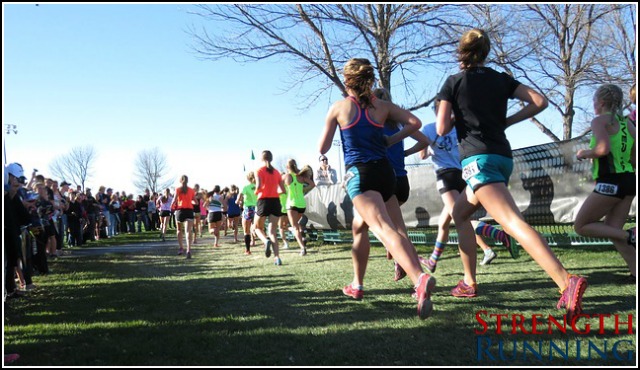There are so many ways of improving: higher mileage, strength training, faster workouts… But if you want to know how to run faster, which is best for you?

No matter who you are or how long you’ve been running, there are concrete ways to reduce your injury risk, run more consistently, and learn how to run faster.
But each training strategy is different and not always appropriate for every runner. You might be ready to hit the gym for more advanced weightlifting or start running 50 miles per week but that doesn’t mean I am!
Instead, I want to highlight three archetypes of runners. You might not exactly fit into one of these categories but they’ll give you a good idea of the necessary steps for improvement.
A majority of runners find themselves in these situations regularly.
Now, you’ll know more about the options available to you, so that you can keep making progress toward your goals.
But first, which runner are you?
The Often Injured Runner

Every few days, I get a variation of this question:
“I can get to about 2 miles and then my knee starts to hurt. Should I keep trying to train for the half marathon?”
With any substantial injury, you can’t focus on treatment while trying to train for a race. Only healthy runners can train well.
The goals and approach are very different so it’s far more effective to focus on one thing at a time.
This is why…
- Runners focus on weight loss before we focus on training
- Bodybuilders focus on gaining size before they focus on leaning down
- We should always focus on treatment before training
This sentiment was explained well by performance coach and author of Peak Performance Brad Stulberg:
There is this myth that you can have it all. You can’t. And trying to live up to that myth will only leave you frustrated. Going “all-in” on some things by definition means much less energy for other things. That’s OK. If you want to be a maximalist you’ve got to be a minimalist.
— Brad Stulberg (@BStulberg) October 29, 2018
So if you do find yourself chronically injured, injury prevention must be a priority if you hope to get off the dysfunctional merry-go-round.
Three of the most effective strategies for staying healthy include:
- A 10-minute series of dynamic warm up exercises before you start running
- Slowing down your easy runs (easy should feel easy: controlled, comfortable, and conversational)
- A 10-20 minute sequence of runner-specific strength exercises after each run
Building athleticism, increasing strength, and reducing some stress are sound ways to stay healthy.
Of course, the most important aspect of injury prevention is not strength training (or foam rolling… or ice baths… or compression socks…) but the structure of your training.
I spoke about this in this video.
To learn more about this training structure – and why it’s far more productive at preventing injuries than gym work – we have a free email course set up for you.
Sign up here and you’ll get the first coaching lesson right away.
The High-Achieving Runner
Running is fun!
This is the runner that we all aspire to be. Healthy, running strong, and well informed about how to train effectively.
Despite everything going well, they’re not entirely sure what to do next. How can they keep progressing? What more can this runner do?
It’s true that the faster you get, the harder it is to keep improving.
Just look at me: in the first 9 months of my running career, I went from a 6:20 mile to a 5:02 mile. But it took seven more years to run 4:33!
Any runner who is bumping up against their physiological limits must be looking at “the next logical step” in their training.
After all, if you want your race times to improve, you have to first improve your training.
You’re probably in this category if you find yourself:
- Running well but without many Personal Bests
- Race times have stagnated
- You think you’re doing everything “right” but your results aren’t budging
These runners need to take the next step. Two of the most effective strategies include running higher mileage and lifting weights.
Higher mileage is arguably the best way to improve. The benefits are undeniable:
- Denser mitochondria, the “energy factories” of muscle cells
- Stronger muscles and more resilience to injuries
- Higher capacity for work (the ultimate runner’s dream)
When you can run a lot, running faster gets a lot easier.
Weightlifting is another great option for high-achieving runners who want to figure out how to run faster. The benefits include:
- More strength, power, and global athleticism
- Improved running economy (so you can go faster at the same effort)
- Better ability to sprint and kick hard at the end of a race
- Injury prevention
A periodized, progressive, and runner-specific strength program has the potential to dramatically transform your running career.
Since most runners don’t lift weights (and those who do don’t lift as appropriately as they could be), there’s a lot of potential for improvement.
If you’re not sure where to start – or you’re looking for a “one and done” strength program for runners, we’ve got you covered.
Our free strength series will show you the mistakes to avoid, sample exercises, case studies, and more.
The Lost Runner

No, I don’t mean lost when out for a run. That will happen to all of us sooner or later!
This is the runner that struggles with consistency. They sit down on Sunday night and wonder what they’re going to run this upcoming week.
Many runners are in this position. They’re just not sure if they’re doing the right thing. They ask questions like:
- “I just want to be more consistent. How do I keep improving?”
- “I’m not sure if I’m doing the right thing… I hate wondering what to do!”
- “I’ve been at 2:10 in the half marathon forever. I don’t think I’ll ever go sub-2:00.”
If you find yourself afloat in a sea of conflicting information, have hope! Shore is just over the horizon…
First, recognize that any lack of consistency might just be because you’re bored. And that’s ok! Running can get repetitive sometimes…
But a varied running program can alleviate boredom. It’s like Coach Mario Fraioli recently said:
Variety isn’t just the spice of life, it’s also key to a sound training program. Work on strength, speed, and endurance to varying degrees throughout the year, switch up the types of races you do, the environments train in, etc. Consistency doesn’t have to mean a lack of variety.
— Mario Fraioli (@mariofraioli) October 16, 2018
I’ll add that trail running can be an exceptionally fun way to inject more exhilaration into your running!
But if variety isn’t your problem, I recommend a three-step approach for these runners:
- Read a running book. It doesn’t matter too much which book it is, but choose one that explains the training process.
- Be patient! Learning something new and developing competence takes time (often years).
- Find support: a coach, running partner, training group, or online community of other runners like you.
Immersing yourself in the sport is one of the most fun ways of learning more about running. You’ll also improve at a faster rate!
But it’s also true that finding a club that works with your schedule or hiring a personal running coach can be difficult or expensive. And we all don’t have friends who want to run with us at 5:30 in the morning…
Strength Running has an affordable group coaching program called Team Strength Running that makes your running easier.
For those who want a supportive team, coaching guidance, and ongoing education about the sport, this is for you.
Get notified when enrollment opens next and I’ll send you all the details when it’s time.
Stacking the Building Blocks of Improvement
Learning!
Progress is not guaranteed. But for those runners who want to know how to run faster, we have the tools to make it happen.
Just like there is a hierarchy of injury prevention, there’s also a hierarchy of speed development:
- Develop some fitness to run consistently and build your ability to run even more
- Learn more about running. Knowledge is a competitive advantage!
- Focus on injury prevention to stay healthy and build momentum
- Lift weights to improve strength and resiliency
- Run higher mileage
- Run faster, longer, or more frequent workouts
Depending on where your running is at the moment, you now have new ideas and strategies to keep progressing.
Instead of implementing all of these suggestions at once, choose one at first and get comfortable with it. After a few weeks, you’ll be ready to start incorporating more of these strategies.
After a few months, you’ll be a whole new runner.
Before you go, I have questions for you!
What is your favorite strategy for running faster? How do you improve when you’ve hit a performance plateau? What works for you?
Leave your recommendations in the comments below and I look forward to seeing what you come up with!